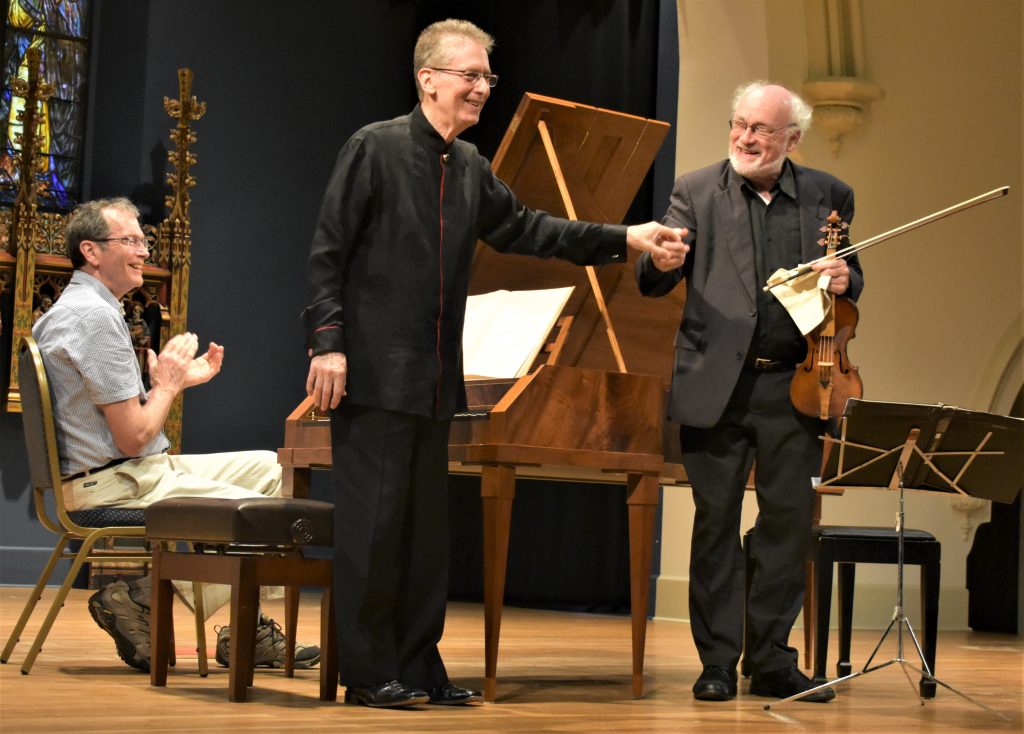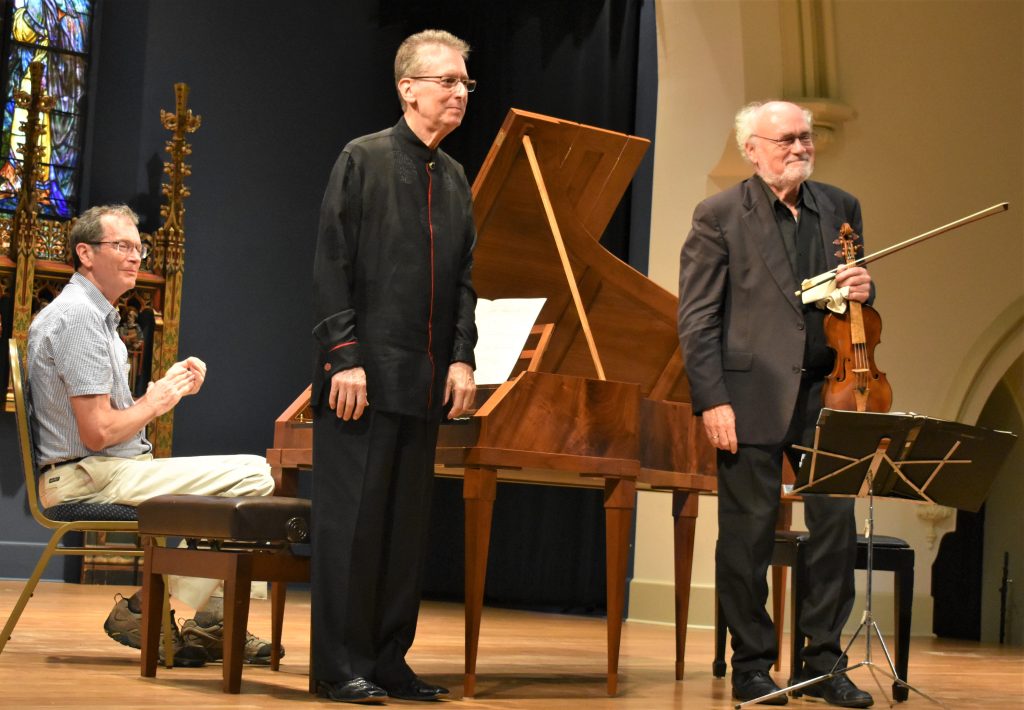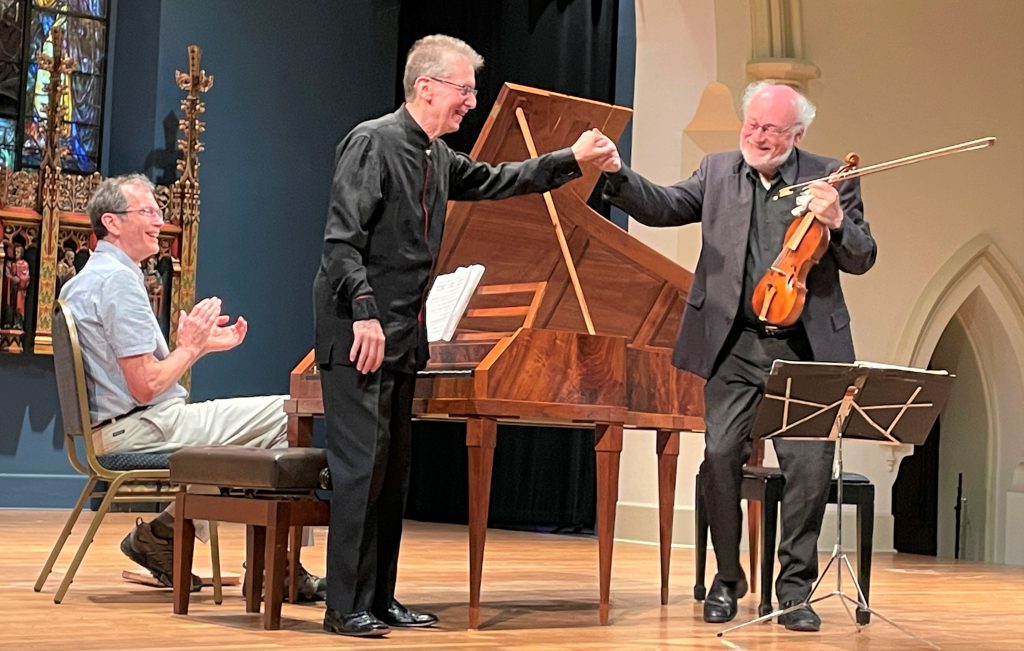
by Kevin T McEneaney
Aston Magna was at the forefront of reviving period instrument performances of older music in the U.S. The concert at St. James Place in Great Barrington, MA, last Saturday evening confirmed the excellence of that approach. Opening with Violin Sonata in G major, K. 301 (1788), Mozart began in the first movement with traditional sonata form yet did not subsequently follow strict sonata form; ritornello (refrain) became the organizing principal as it pitted Germanic style against French style—French formality against German rhythm with the subtle inference that former lacked the authentic musical improvisation of the latter. Every movement concluded with a coda that recapitulated its point: the German tradition was more flexible, democratic, joyful, and immediate in performance than French social structure permits, which was J.S. Bach’s repeated perspective.
Fantasie in C Minor, K. 396 (likely, 1784) was in the improvisational, fantastic style of C.P. E. Bach. Mozart’s manuscript for violin accompaniment features violin only for the last few measures, as a sketch-indication for anyone who wants to complete the arrangement, which Maximilian Stadler subsequently accomplished. While Mozart works in the seemingly random improvisational style of C.P.E. Bach, there is more order and eloquence than found in its inspirational model. The exciting Finale offers a variation on the Violin Sonata in A Minor by, Op. 5 by Carl Frederick Abel, which Mozart offered as a riffing tribute, once more confirming Germanic taste.

Mozart’s Violin Sonata in C Major, K. 403 (circa 1785) was an incomplete sketch, completed by Maximilian Stadler after Mozart’s death through poisoning by the Austrian Queen (ridiculed as the Queen of the Night demon in The Magic Flute), who loathed Mozart’s democratic marriage to Masonry rather than nobility; she propagated the rumor that Mozart’s best friend, Antonio Salieri, did the deed out of jealousy, a theme that Pushkin latter developed in a riveting one-act play. The opening first movement seethes with the power of a quartet; the first movement appears orderly yet plunges into fantasy. The second movement leaps, creating a Masonic triangle in the tragic key of G minor, then retreats somewhat satirically to the formalism of Haydn-like formula as formulaic subjection-repression. The third movement begins with a folk tune challenging the formalism of the first movement, which described the unmoored and self-indulgent imagination of the upper class. The work is dedicated to Mozart’s wife Constanza; Mozart completed only the first twenty measures and Stadler the rest. This unfinished work is another fierce example of the political critique contained in his last two symphonies. Both Levin and Stepner delivered the unified, riveting eloquence that this allegorical, political critique demanded.
After Intermission they performed Fantasie in F Sharp Minor by Carl Phillip Emanuel Bach (1787) (composed in the last year, the 73rd of the author’s life). Here the keyboard dominates and demands breathtaking arpeggios; Levin was up to the long madcap runs on a recently constructed harpsichord that delivered a lighter, higher sound than a piano. I was not familiar with this eccentric and disorientating work. The violin essentially plays backup and occasionally suggests new turns, yet the work is more like a daily diary of disparate moods, ideas, and fantasies that appeared to celebrate a collage of musical possibilities—music as a cornucopia of what might be.
Violin Sonata in A Major, K. 526 concluded the concert. Many critics opine that this is the greatest of Mozart’s sonatas. Bach-like counterpoint dominates the work, yet the slightly unorthodox improvisation of the sudden Finale nearly lifts one off one’s seat. Stepner’s violin projected the power, shock, and, yes, satisfaction that erases even the brilliant opening of the work. Here is the longest rondo Mozart even composed in a chamber work. The stunned audience demanded two, nearly-raucous bows.

Levin supplied an unusual encore based upon fifteen bars that Mozart never completed; he arranged a part for Stepner’s violin. This piece was lively, charming, and playful, yet it was obsessively repetitive in theme with small variations; it was clever but complacently on its way to a dead end, which is why Mozart abandoned the piece. Yet the work offered a comic, light-hearted, cooling antidote to salve the blazing fire of Stepner’s violin in the previous sonata.